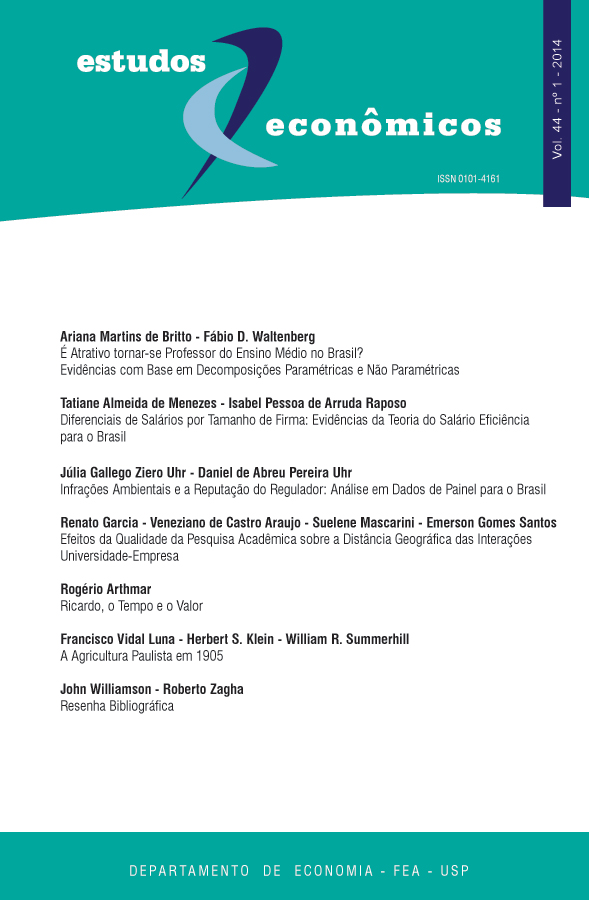Ricardo, o tempo e o valor
DOI:
https://doi.org/10.1590/S0101-41612014000100005Keywords:
Ricardian economics, Labor theory of value, Time, Profit rateAbstract
This paper reviews the evolution of the Ricardian theory of value in its connection with
the element time. Initially, Ricardo’s first version of the general law of exchange is briefly
inspected. After that, a numerical illustration of the formula for competitive prices
is detailed, while some light is shed on how the factor time arose in the discussions
about the theory advanced in the Principles. Next, the simplified version of the norm of
value introduced in the book’s third edition is examined, as well as the central Ricardian
proposition that changes in the profit rate would have minimum impact on prices. The
last section shows that a generalization of the same example concocted by Ricardo,
incorporating multiple production periods, does not lend support to such assertion.
Downloads
References
ALDRICH, John. Ricardo on value: the three chapter ones. University of Southampton, UK. Disponível em: <http://www.economics.soton.ac.uk/staff/aldrich/ricardoindex.htm>. Acesso em 05 de março de 2013. Página criada em 2002.
BARKAI, Haim. The empirical assumptions of Ricardo’s 93% theory of value. Economica, New Series, 43, p. 418-423, 1967.
BLEANEY, Michael. Underconsumption theories. A history and critical analysis. New York, International Publishers, 1976.
COCHRANE, James L. The first mathematical Ricardian model. History of Political Economy, v. 23, n. 2, p. 419-431, Sep 1970.
HOLLANDER, Jacob. Two letters on the measure of value. Baltimore: Johns Hopkins, 1936.
HOLLANDER, Samuel. The economics of David Ricardo. Toronto: University of Toronto Press, 1979.
LOPES, Francisco L. The Ricardo puzzle. History of Political Economy, v. 40, n. 1, p. 595-611, 2008.
McCULLOCH, John R. Mr. Ricardo’s theory of exchangeable value vindicated from the objections of R. The Edinburgh Magazine and Literary Miscellany, p. 429-431, November 1818.
O’BRIEN, Dennis P. The classical economists revisited. Princeton: Princeton University Press, 2004.
PEACH, Terry. Interpreting Ricardo. Cambridge: Cambridge University Press, 2009.
POLITICAL ECONOMY CLUB [PEC]. Minutes of proceedings, 1899-1920, roll of members and
questions discussed, 1821-1920. Volume VI. London: Macmillan, 1921.
SCHUMPETER, Joseph A. History of economic analysis. London: George Allen & Unwin, 1963.
SOWELL, Thomas. 1972. Say’s Law. An historical analysis. Princeton: Princeton University Press.
SRAFFA, Piero (Ed.) The works and correspondence of David Ricardo [Works]. Indianapolis: Liberty Fund, vs. I-IX, 2004.
ST. CLAIR, Oswald. A key to Ricardo. New York: Augustus M. Kelley, “Reprints of Economic Classics”, 1965.
STIGLER, George. Ricardo and the 93% labor theory of value. The American Economic Review, v. 48, n. 3, p. 357-367, 1958.
TORRENS, Robert. Strictures on Mr. Ricardo’s doctrine respecting exchangeable value [1818]. In: P. D. GROENEWEGEN (ed.) The economists refuted and other early economic writings. Robert Torrens. Fairfield: Augustus M. Kelley, p. 77-82, 1993.
WILSON, George W., PATE, James L. Ricardo’s 93% labor theory of value: a final comment. The
Journal of Political Economy, v. 76, n. 1, p. 128-136, 1968.
Downloads
Published
Issue
Section
License
Copyright (c) 2014 Rogério Arthmar

This work is licensed under a Creative Commons Attribution-NonCommercial 4.0 International License.
By submitting an article, the author authorizes its publication and attests that it has not been submitted to any other journal. The original article is considered final. Articles selected for publication are proofread for grammatical and orthographic errors. The journal does not pay rights for published articles. The Institute of Economic Research from the School of Economics, Business and Accounting of the University of São Paulo (Instituto de Pesquisas Econômicas da Faculdade de Economia, Administração e Contabilidade da Universidade de São Paulo) owns the journal's copyright.





 Atualizado em 14/08/2025
Atualizado em 14/08/2025